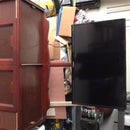Introduction: Creating a Tabletop Out of Reclaimed Bowling Pins
One of my friends and his wife are avid bowlers, and he came to me with a question:
"I got a ton of bowling pins from an alley and I want to get a table made out of them, do you know how to do that?"
My answer: "Not a clue, but I'll figure it out."
This is a step by step tutorial on how to build a similar table using reclaimed bowling pins - I think it came out fairly nice!
Step 1: Get Bowling Pins
Pretty self-explanatory.
Step 2: Cut Your Seams Into the Bowling Pins
I've seen a few methods for plastic removal on this site before, but I decided to take a new approach.
You will need:
-GOGGLES (trust me - the acrylic shield didn't happen just because it looks cool.)
-A Dremel Multitool
-Pair of pliers
-Some scrap acryclic
-Wire
-3/8" saw blade attachment for Dremel
I recommend drawing a black line on the seam of the pin to guide you as you work w/ the blade.
I found that working from left to right would burn the plastic, and moving from right to left would gather the melting plastic on the blade. You can then pull the plastic off of the saw blade with pliers or a multitool. Let that plastic build up too long and you will start flinging molten pin plastic all over your work space.
Step 3: More Pics.
Step 4: Remove the Plastic
After scoring the plastic with a razor knife (please cut AWAY from your body!) you can take your pliers and pull the plastic off in small sections.
Step 5: Cut Bowling Pins in Half, Lengthwise
I used a fine toothed sawblade on a compound miter saw, but switched to a ripping blade for subsequent cuts due to burning the wood while cutting these pins in half. Also, PLAN YOUR CUTS! I lost 2 full pins because I didn't plan well when starting the cut and they came out crooked. It got to be REALLY frustrating having to start all over from the plastic peeling stage.
Step 6: Plan Your Tabletop
My other friend's wife suggested the concept for this table, which involves suspending support rails into cutouts in the fattest part of the bowling pins. These pictures are a rough mockup for proof of concept.
Cutting the channels was difficult, because you have to keep the flat side of the pin COMPLETELY level while making your cuts. I used my table saw, making incremental passes, and removed excess wood with chisels.
Step 7: Prep the Pins for Paint and Finish BEFORE Assembly
Wood Filler (I used WoodMax) is your best friend here - any rough patches or saw marks can be filled and sanded smooth again. Remember that we're still looking at the bottom of the table here.
Step 8: Paint the Pins!
A scrap block of wood here helps ensure that you don't get paint into the channel, which could impair installing the support rails in the next step.
Step 9: Install Your Support Rails
For this step, I used 1X4 lengths of red oak, and PL375 construction adhesive to hold it all together. It is VERY important that you make sure your work surface is level on this step! If you put these rails in crooked, it's going to be pretty difficult to get them out again.
Step 10: Prep the Top of the Table
After waiting a day or two for the glue to dry, prep the top of the table w/ 220 grit sandpaper. I also taped around the perimeter of the table before staining to prevent stain from dripping on to the paint job.
Step 11: Stain the Tabletop!
Here, I used a spray on red stain from Minwax - the aerosol mist was much easier to control, and I was able to get stain into crevices without too much trouble.
The first picture is after 1 coat of stain, the second picture is after 2 coats. I applied a clear lacquer after staining.
Step 12: Finishing Up
Now you can attach legs, put glass on top, and do whatever you want to make this table your own! These are pictures of my finished project.
I hope you've enjoyed reading about my project as much as I enjoyed building it!

Participated in the
Instructables Design Competition

Participated in the
Furniture Contest













